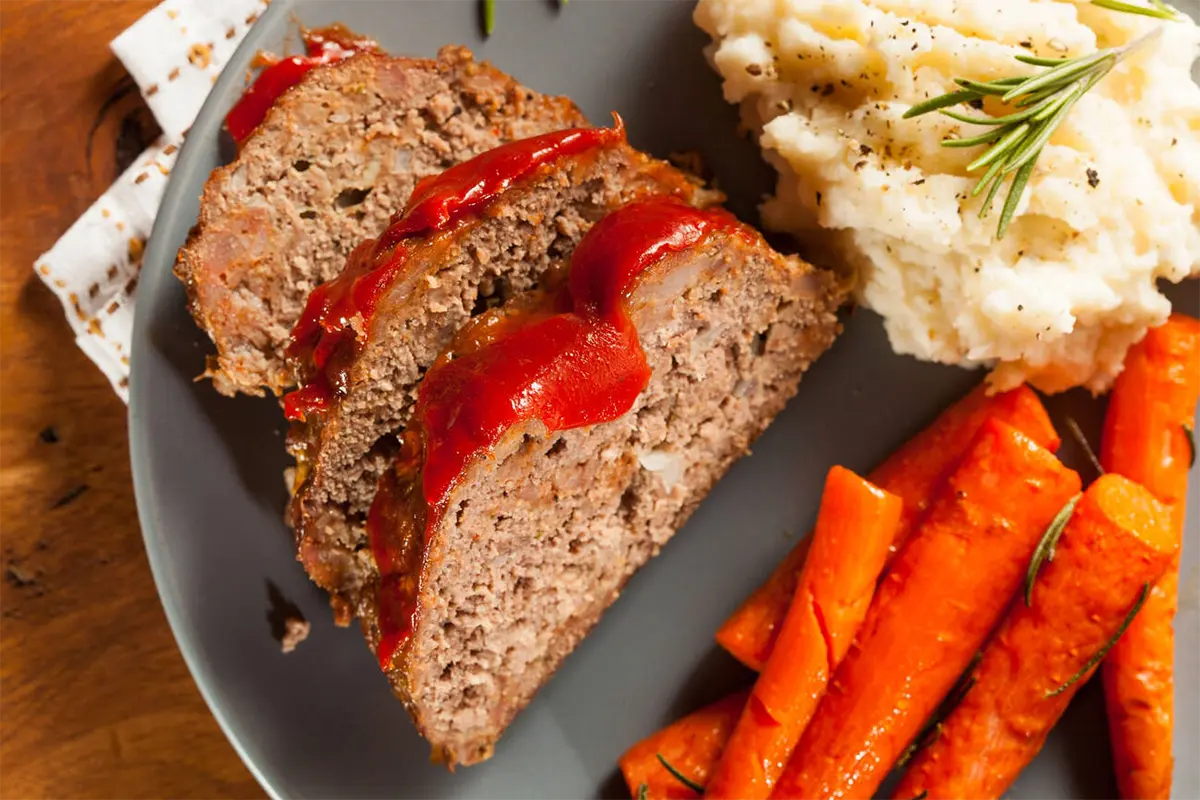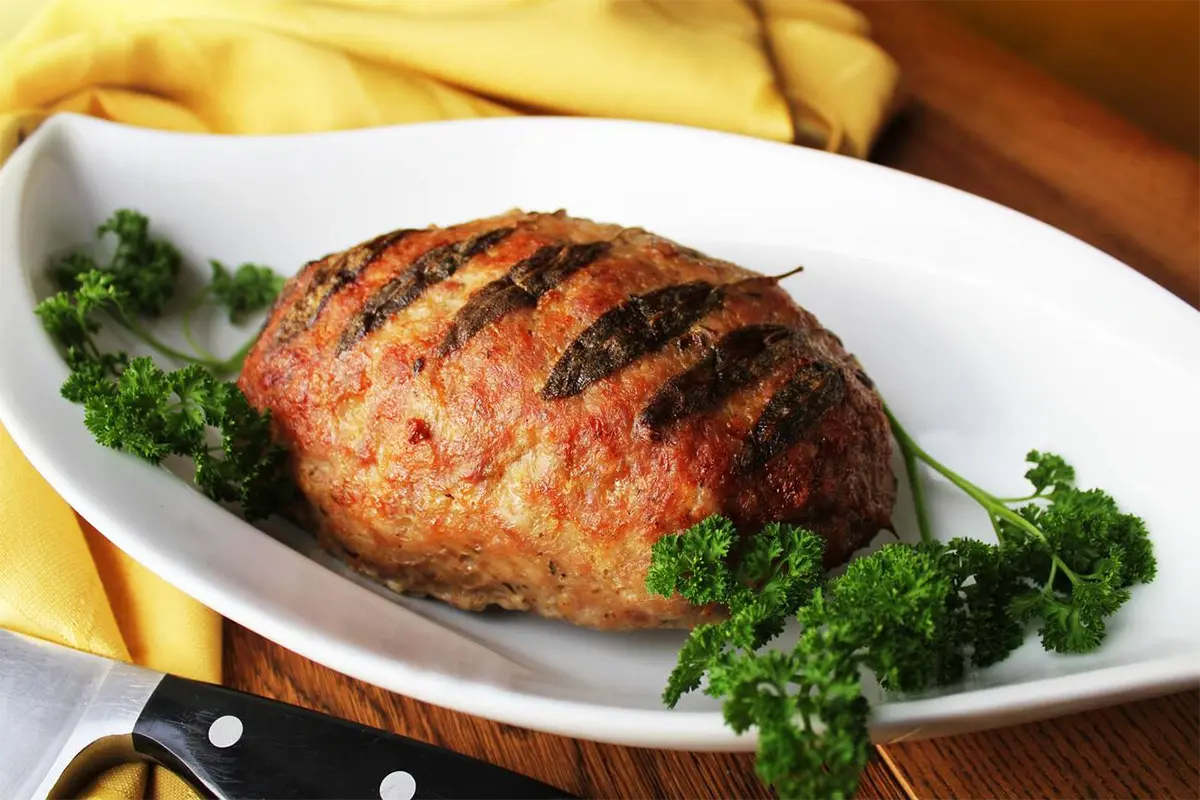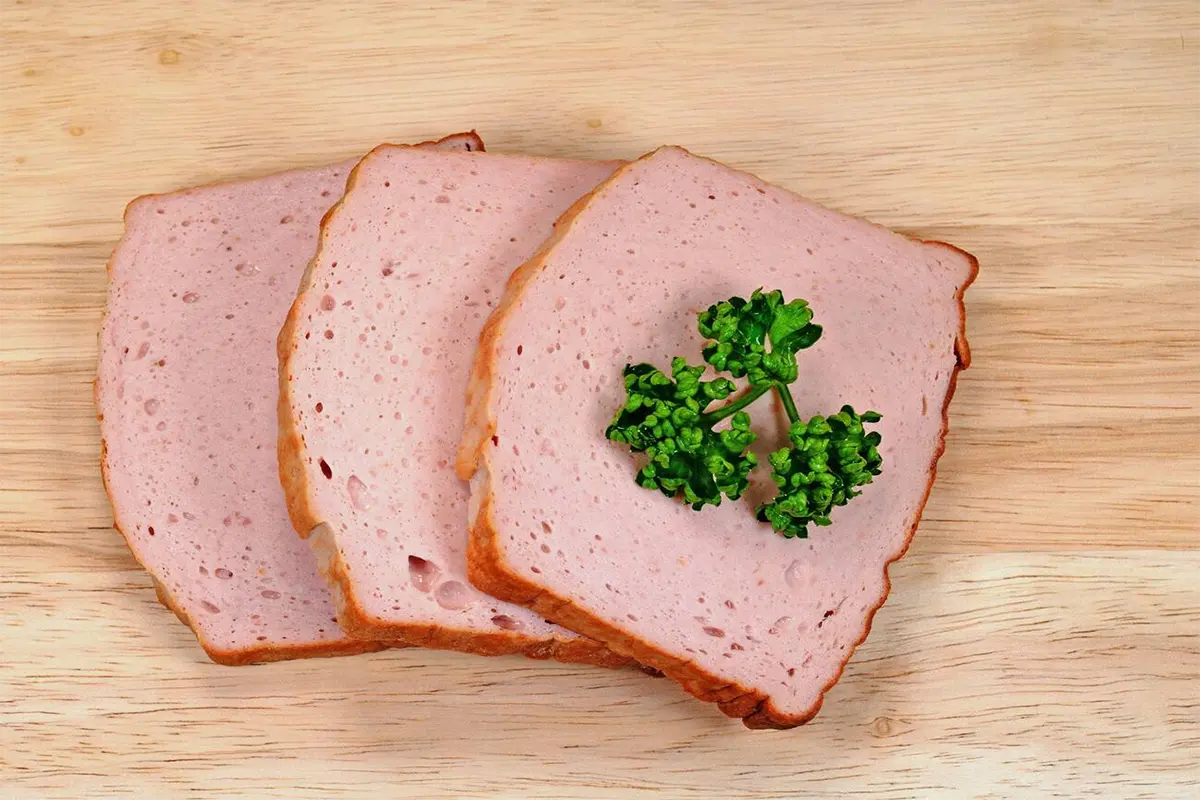Exploring Tender Meatloaf Meatloaf isn’t just a dish; it’s comfort in a slice, a piece of home. The quest for the perfect meatloaf involves mastering a blend of flavors, textures, and the happiness cooking brings.
Why Meatloaf Wins Hearts What makes meatloaf so beloved? It’s the ultimate comfort food, connecting cultures and communities with its welcoming warmth. It’s a meal that brings people together, filling homes with its enticing scent and hearts with contentment.
Solving the Meatloaf Puzzle Perfecting meatloaf is a complex puzzle, but one many are eager to solve. It’s not just about mixing meat and spices. It’s crafting a symphony of ingredients and methods. So, let’s unravel the secrets to a spectacular meatloaf for your next meal.
Foundations of Flavor and Texture
Selecting the ideal ingredients is vital for making the ultimate meatloaf, as it beautifully balances flavor and texture. To begin, choosing the right meat is critical. A combination of ground beef for its rich flavor and ground pork for juiciness creates a perfect base. Furthermore, for those looking for a lighter option, ground turkey or chicken can substitute, though adding moisture becomes crucial due to their lower fat content.
Moreover, breadcrumbs soaked in milk play an indispensable role. They not only bind the loaf together but also ensure it remains moist and tender. Similarly, eggs are key for binding and enriching the meatloaf’s texture.
Additionally, incorporating finely chopped onions and garlic adds both moisture and depth of flavor. Herbs like thyme or parsley, alongside salt and pepper, enhance the dish, bringing freshness and complexity.
Furthermore, sauces such as Worcestershire, ketchup, or mustard introduce an additional layer of taste. These not only boost flavor but also help maintain moisture, ensuring every slice is juicy.
Finally, the glaze on top, typically a mix of ketchup, brown sugar, and a touch of vinegar, provides a caramelized crust. This contrasts wonderfully with the moist interior, adding a sweet and tangy finish that complements the savory meatloaf.
In essence, crafting a delightful meatloaf demands thoughtful consideration of each component’s role in achieving the right mix of flavors and textures. By judiciously balancing these elements, you can create a meatloaf that is not only mouthwatering but also deeply satisfying, proving to be a cherished dish for any meal.
The Best Meats for Meatloaf
Choosing the right meats is crucial for crafting the perfect meatloaf, with each type of meat contributing uniquely to the final dish. Firstly, a mixture of beef, pork, and veal creates a rich and complex flavor profile. Specifically, beef offers a strong, hearty taste, while pork adds necessary fat, ensuring the loaf remains juicy and flavorful. Additionally, veal brings a delicate tenderness that can’t be achieved with beef and pork alone.
Moreover, for those seeking healthier alternatives, turkey or chicken serve as excellent substitutes. These leaner options are not only lower in fat but also high in protein, making the meatloaf more suitable for a variety of dietary preferences. However, it’s important to remember that lean meats tend to dry out more easily. Therefore, incorporating additional moisture through ingredients like milk-soaked breadcrumbs or grated vegetables is essential to maintain the meatloaf’s tenderness.
Furthermore, experimenting with different meats can lead to new and exciting flavor combinations. For instance, adding a small proportion of chorizo or Italian sausage can introduce a spicy kick, elevating the meatloaf from traditional to extraordinary.
In conclusion, the selection of meats plays a pivotal role in determining the flavor, texture, and overall appeal of meatloaf. By carefully balancing lean and fatty meats, and incorporating moisture-enhancing ingredients when using leaner options, you can create a meatloaf that is not only delicious but also caters to a wide range of tastes and dietary needs.
Enhancing Ingredients for Moisture and Binding

A slice of home: Discover the warmth of a tender, juicy meatloaf.
Moreover, to ensure your meatloaf is moist and cohesive, key elements like eggs and breadcrumbs are essential. Eggs act as a binding agent, seamlessly melding the ingredients, while breadcrumbs help retain moisture within the loaf, crucial for that juicy meatloaf texture. Enhancing this effect, soaking the breadcrumbs in milk or broth before mixing can provide even more moisture. Additionally, incorporating moisture-enhancing vegetables like onions and garlic not only adds depth but also enriches the flavor. Seasoning with herbs and spices further accentuates the meat’s natural richness. Finally, incorporating sauces such as ketchup, BBQ sauce, or Worcestershire sauce can elevate the overall flavor, making your meatloaf truly memorable and deliciously juicy.
Balancing Lean and Fat for Perfect Texture
Creating the perfect meatloaf texture requires balancing lean meats with the right amount of fat.
The Secret Ingredient: Fat
Interestingly, fat is the secret ingredient that adds flavor and juiciness to meatloaf. A mix of 80% lean to 20% fat in beef is often ideal. This ratio ensures that the meatloaf remains moist and flavorful throughout cooking.
Creative Fat Sources Beyond Beef
Additionally, exploring other fat sources can add unique flavors. For instance, adding chopped bacon or sausage introduces a smoky taste. Similarly, incorporating olive oil or butter can enhance richness. For those preferring lighter options, avocados or nut butters offer healthy fats without compromising moisture.
Gentle Touch for a Tender Loaf
Achieving a tender meatloaf demands careful mixing and shaping. Here’s how to do it right.
The Art of Mixing: Less is More
Firstly, when combining your ingredients for that perfect juicy meatloaf, mix gently. Overworking the meat can lead to a tough loaf. Aim for a light touch, blending just until the ingredients are incorporated. This approach ensures your meatloaf stays tender and juicy, capturing the ideal texture and flavor that makes this dish a beloved classic.
Shaping Your Loaf: A Delicate Process
Next, shaping your loaf for a juicy meatloaf is a delicate task. Gently form the meat into a loaf shape. Avoid pressing too hard; a loose structure allows heat to circulate evenly, cooking the meatloaf thoroughly without drying it out. This technique is key to maintaining the moisture and ensuring every slice is as juicy as it is delicious.
Oven Temptations: Baking Your Meatloaf
Baking your meatloaf correctly is key to transforming it into a delectable treat. Let’s explore the best practices.
Firstly, the oven temperature plays a crucial role. Preheating your oven to the right temperature, typically around 350°F (175°C), ensures that the meatloaf cooks evenly and develops a delicious crust.
Secondly, consider the baking time. A standard meatloaf usually requires about an hour in the oven. However, the actual time can vary based on the loaf’s size and your oven’s characteristics. Using a meat thermometer is a reliable way to check doneness. Aim for an internal temperature of 160°F (71°C) for beef-based meatloaf’s.
Moreover, the question of whether to cover the meatloaf while baking arises. Covering can help retain moisture, preventing the meatloaf from drying out, especially in the initial cooking phase. Uncovering it towards the end allows the outside to become beautifully browned and the glaze to caramelize.
Furthermore, the baking vessel also matters. A loaf pan offers a traditional shape and helps the meatloaf cook uniformly. For a crustier exterior, shape the loaf and place it directly on a baking sheet, allowing air to circulate around the entire loaf.
Finally, resting the meatloaf after baking is as important as the cooking process itself. Allowing it to rest for about 10 minutes before slicing helps the juices redistribute, ensuring each slice is moist and flavorful.
In essence, mastering these oven techniques guarantees a meatloaf that’s not only tasty but also visually appealing and satisfying to the palate. By paying attention to temperature, timing, and finishing touches, you can elevate your meatloaf from good to unforgettable.
To Cover or Not to Cover?
Deciding whether to cover your meatloaf during baking comes down to a preference between moisture and crustiness. Let’s break down the options.
Leaving the meatloaf uncovered throughout the baking process allows the outside to develop a delectable crust. This method suits those who love a slightly crispy exterior on their loaf. The heat directly interacts with the meatloaf’s surface, creating a richly browned and flavorful crust that many find irresistible.
On the other hand, if your priority is ensuring the meatloaf remains exceptionally moist, covering it with foil for at least part of the bake time is the way to go. This technique traps steam generated during cooking, circulating moisture within the meatloaf. Particularly beneficial for leaner meat blends that might dry out more easily, covering can help maintain a juicy interior.
Ultimately, you might find a combination approach works best. Starting with the meatloaf covered and then removing the foil towards the end of baking combines the benefits of both methods. This way, you lock in moisture early on and finish with a period of direct heat to achieve a tempting crust on the top.
In summary, whether to cover your meatloaf or not depends on your texture preferences. Experimenting with both methods can help you discover the perfect balance for your taste, ensuring a delicious outcome every time.
The Importance of Resting
After baking, let your meatloaf rest. This step is crucial. Resting allows juices to redistribute, ensuring each slice is moist and flavorful. Aim for a 10-minute rest before slicing. This wait guarantees a perfect meatloaf experience every time.
Keeping the Juices Locked In
Ensuring your meatloaf stays moist involves smart strategies. Here’s how to do it effectively.
Breadcrumbs vs. Milk-Soaked Bread
Firstly, using breadcrumbs can help, but milk-soaked bread is better. The milk-soaked bread not only binds but also adds moisture, resulting in a juicier loaf. Simply soak the bread in milk until it’s fully absorbed, then mix it into your meatloaf. This method significantly enhances moisture retention.
Wet Seasonings and Their Roles
Wet seasonings are key players in elevating the flavor and moisture of meatloaf. Let’s explore their contributions.
Incorporating ingredients like Worcestershire sauce, ketchup, or mustard into your meatloaf mixture does wonders. These seasonings not only infuse the loaf with distinctive flavors but also add essential moisture. Worcestershire sauce brings a tangy depth, ketchup offers a hint of sweetness, and mustard delivers a mild kick. Together, they create a complex flavor profile that’s far from ordinary.
Moreover, these wet seasonings contribute to keeping the meatloaf moist throughout the baking process. They help to lock in the natural juices of the meat, ensuring that every slice is as juicy as it is tasty. This is particularly beneficial for leaner meat selections, which tend to dry out more easily during cooking.
Additionally, wet seasonings can be adjusted according to personal taste preferences. For instance, a splash of hot sauce or a spoonful of barbecue sauce can introduce new dimensions of flavor, making your meatloaf uniquely yours.
In essence, wet seasonings are not just about adding flavor; they’re about enhancing the overall sensory experience of meatloaf. By judiciously choosing and combining these ingredients, you can ensure your meatloaf is not only moist and tender but also richly flavored and irresistible.
Juicy Meatloaf Recipe: Ingredients and Directions for Ultimate Flavor
Creating the ultimate tender meatloaf starts with selecting simple ingredients and following careful steps. Let’s dive into the process.
Ingredient List
- 1 lb ground beef (opt for an 80/20 mix for the best flavor and juiciness)
- 1/2 lb ground pork (this adds extra juiciness)
- 1 cup milk-soaked bread (use about 2 slices, with crusts removed)
- 2 large eggs (they act as the binding agent)
- 1/2 cup finely chopped onion
- 2 cloves garlic, minced
- 1/4 cup ketchup
- 2 tablespoons Worcestershire sauce
- 1 teaspoon salt
- 1/2 teaspoon black pepper
- 1/2 teaspoon dried thyme
- For the glaze:
- 1/2 cup ketchup
- 1 tablespoon brown sugar
- 1 teaspoon mustard
Step-by-Step Directions

Essential elements for a cohesive and moist meatloaf
- Preheat your oven to 350°F (175°C).
- Soak the bread in milk until it’s fully absorbed; this is a crucial step for moisture.
- Combine the meats, milk-soaked bread, eggs, onion, garlic, ketchup, Worcestershire sauce, salt, pepper, and thyme in a large bowl. It’s important to mix gently to keep the meatloaf tender.
- Form the mixture into a loaf shape on a baking sheet. This step requires a delicate touch to ensure even cooking.
- Prepare the glaze by mixing ketchup, brown sugar, and mustard. Then, generously spread it over the meatloaf for a flavor boost.
- Bake the meatloaf in the preheated oven for 1 hour, or until it reaches an internal temperature of 160°F (71°C), ensuring it’s fully cooked.
- Rest the meatloaf for 10 minutes before slicing. This allows the juices to redistribute, enhancing the meatloaf’s moistness and flavor.
Pro Tips for a Masterpiece
- Avoid overmixing: To prevent a dense loaf, mix the ingredients just enough to combine them.
- Monitor the temperature: Using a meat thermometer helps ensure the meatloaf is perfectly cooked.
- Incorporate vegetables: Adding grated carrots or zucchini can introduce extra moisture and flavor.
- Allow for resting: Giving the meatloaf time to rest before slicing ensures each piece is juicy and delicious.
Following these steps and tips will help you create a mouthwatering meatloaf that’s sure to be a hit at any table.
Answering Your Meatloaf Queries
Navigating the world of meatloaf can bring up many questions. Here, we tackle some common queries to help you perfect your dish.
Can I make meatloaf without eggs?
Absolutely, you can make meatloaf without eggs. Eggs act as a binder, but alternatives like mashed potatoes, breadcrumbs soaked in milk, or flaxseed mixed with water can also do the job. These substitutes help keep the ingredients together and maintain moisture.
How do I prevent my meatloaf from falling apart?
To keep your meatloaf from crumbling, use the right binder-to-meat ratio. Typically, a half cup of breadcrumbs or oatmeal for every pound of meat works well. Ensuring your meatloaf mixture isn’t too wet or dry is key. Also, don’t skip the resting period after baking; it helps the meatloaf set and stay together when sliced.
What’s the best way to reheat meatloaf?
Reheating meatloaf without drying it out involves gentle heat and moisture. Cover slices with foil and bake at a low temperature, around 250°F (120°C), until warmed through. Alternatively, adding a splash of beef broth or water before covering can help maintain its juiciness. For a quicker method, microwave slices with a damp paper towel over them to keep the moisture in.
Juicy Meatloaf: Beyond the Basics to Elevate Your Dish
Mastering meatloaf means constantly seeking ways to enhance it. Here’s how you can elevate your next loaf.
Exploring International Meatloaf Variations
Firstly, venturing into international flavors can transform your meatloaf. Try mixing in spices like cumin or coriander for a Middle Eastern twist. Alternatively, incorporating Italian herbs and Parmesan cheese offers a taste of Italy. Each region’s unique blend of spices and ingredients can inspire a whole new meatloaf experience.
Pairing Sides for the Ultimate Meal
Additionally, choosing the right sides can turn meatloaf into a feast. Mashed potatoes are a classic choice, but why not spice them up with garlic or cheese? For a lighter option, a crisp green salad or steamed vegetables complement the richness of the meatloaf. Also, consider serving fresh bread or rolls to soak up any delicious juices.
LSI and NLP Keywords
- Tender meatloaf secrets
- Juicy meatloaf tips
- Meatloaf ingredients for moisture
- How to make meatloaf not dry
- Best meat for meatloaf
- Meatloaf mixing techniques
- Cooking meatloaf perfectly
- Meatloaf resting time
- Meatloaf FAQs
External Links and Recommended Anchor Text
- USDA Guidelines on Ground Beef Safety – “Understanding Ground Beef Safety”
- Culinary Arts Techniques – “Culinary Techniques for Perfect Meatloaf”
- Food Science on Meat Textures – “The Science Behind Meat Textures”

